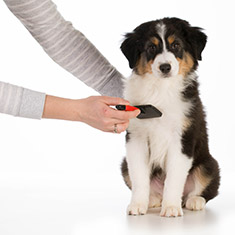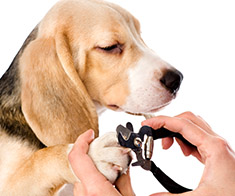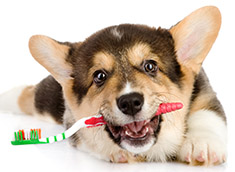Bonding with your Puppy Through Grooming
We all know that most dogs will need some sort of grooming during the course of their lives. Even short-haired dogs need to have their nails clipped or the occasional burr brushed from their fur. And many dogs are not overly happy with the prospect. How do you make this process easier and more enjoyable for both you and your dog? By starting early and making it fun, of course.

Grooming should be fun
Puppies are all about play, and if you can make grooming fun, you will have won more than half the battle. For example, if your dog shies away from being brushed, there are several things you can try to make it less scary and more fun.
First of all, make sure you are using the proper brush for the kind of fur your dog has. If you use a brush that is not designed for curly hair on a Poodle, chances are you will pull the fur and scare the dog. Ask a local groomer, vet or even the pet store employee for suggestions about the type of brush to use for different fur textures.
Next, move slowly enough that your dog has time to see the brush coming at him and to sniff or otherwise check the instrument out before you begin using it. The first couple of times you bring the brush to the dog, you may want to simply allow him or her to check it out, sniff it, taste it, and paw at it without your ever making a move toward brushing. If the dog has thoroughly investigated the brush under non-threatening circumstances, he or she is less likely to be afraid of it later.
Once you are sure that brushing isn’t painful or overly alarming, your job is to make your puppy associate being brushed with something pleasurable. If your dog tends to cooperate with the brushing based only on the fact that he or she is getting to spend time with you, it may be enough to give the dog a short brushing then playing with the puppy afterward. Future sessions can be made longer and longer until you are able to completely groom the dog in one session.
However, if your dog is more resistant to the brush, you may have to do a little distraction and bribing. You may have to start out with two people if you feel like you don’t have enough hands. Have one person get the dog interested in a tug toy or another favorite game, and keep the dog occupied with that, while you brush the dog’s haunches. Once the dog allows you to do that much, give him or her a treat and a bunch of praise, then leave the rest of the grooming for another day.

The next time, attempt to brush a little more of the dog during the tug-o-war match before stopping for a treat. Each day, go a little farther until you are able to groom the entire dog while he or she is being distracted by a game of tug. Next, start the process over without the game of tug. Begin by brushing only a small area, then giving a treat and lots of praise. When you have finished the small area, play with the dog using the favorite toy. If the dog’s game for more, brush another small area, give a treat, and play. Continue to add more brushing each day until you can eventually brush the entire dog without having to interrupt the sequence with play and treats. If you teach your dog in this way, he or she will be more than willing to submit to grooming throughout his or her life.
Trimming your puppy's nails
Nail trimming presents special challenges because you have to be very careful not to trim the nails too deeply which is tough to do if the dog is squirming, either from fear or from playing with a toy. So, you need to have another strategy for dealing with this frustrating task. Nail trimming works best when your dog is totally relaxed, but it is tough for your dog to get relaxed if he or she is not used to having his or her feet touched.
Spend some time simply rubbing your puppy’s feet each day. Wait until the dog is ready for nap or until some time when you can sit quietly with your baby for a few minutes. If the animal is small, you may want to do this during lap time in front of the television or some other convenient, relaxing time. Begin the massage at the top of the dog’s leg and slowly work your way down to his or her feet, which are quite sensitive. Use a light touch, showing your dog that feet-touching doesn’t have to be painful or scary.
As you begin to gain the dog’s trust, you will notice that he or she will stay totally relaxed throughout the massage and may even fall asleep. When this happens, you will know the dog is ready to proceed to the next step, getting the dog used to the tool you will be using to groom his or her nails. Just as you did with the brush, simply set the tool near the dog and let the dog explore it before you ever approach the dog’s feet with it. If you will be using an electric grinder, turn it on and allow your dog to get used to the sound before you begin using it. After each step your puppy tolerates, reward him or her with treats and praise.
Teeth, ears, and shampooing

The process for tooth brushing is the same. Allow the puppy to get used to your finger in his or her mouth, then place a small amount of dog toothpaste on your finger and allow the dog to smell and taste the paste before you try to do any actual work on your dog’s mouth. Once the puppy is used to having your finger in his or her mouth, you might upgrade to a finger-pad type toothbrush or to an actual dog toothbrush.
Depending on the type of dog you have, additional grooming such as ear cleaning, fur clipping, or shampooing. In each instance, follow the process outlined above. Take it slow and make it fun. Hold practice sessions with your puppy consistently – daily if possible, but make each session short. Praise liberally and provide positive reinforcement along each step of the way. You should have your dog begging to be groomed in a short while.
For more information, see our Doggies den articles on grooming, as well as this article from Drs. Foster and Smith. Pet Place also has a wonderfully informative article targeting the special issues involved in puppy grooming.
Doggies Den: Latest Articles
 Homemade Thanksgiving Treats for Your Dog
Homemade Thanksgiving Treats for Your Dog
NUTRITION We all want to include our dogs in our holiday celebrations, but hopefully, you're aware that sharing table scraps with your dog isn't always the best idea.
 Keeping Your Dog Safe during the Summer Months
Keeping Your Dog Safe during the Summer Months
HEALTH Summer is coming on fast, so it’s time to plan how you will keep your dog safe and healthy through the lazy, carefree, warm days.
 Vaccination Time Again-Keeping Your Puppy Healthy
Vaccination Time Again-Keeping Your Puppy Healthy
DOG HEALTH So you have your new puppy picked out. There are quite a few shots, treatments and examinations that will keep the newest member of your family healthy.
 Canine Thanksgiving Feast
Canine Thanksgiving Feast
NUTRITION With the wide variety of food at Thanksgiving dinner, chances are you'll want to give your dog something special, too. If you're contemplating what to feed your dog for the holiday, here is a guide to a great Canine Thanksgiving Feast.
 Dog Walking Tips Every Owner Should Know
Dog Walking Tips Every Owner Should Know
DOG FUN Walking your dog is not only crucial to keeping him healthy and happy, it strengthens the bond between your canine friend and his caregiver. There are a lot of obstacles out there. Don’t forget these simple tips to keep your walk fun and safe in the outside world.
 The Benefits of Physiotherapy for your Dog
The Benefits of Physiotherapy for your Dog
HEALTH The same techniques that physiotherapists use to treat a variety of injuries and conditions in humans have been adapted to suit animals with great success. Family pets, show dogs, and working dogs can all benefit greatly from physiotherapy. Dogs whose activities involve a lot of agility are especially susceptible to the types of problems that physiotherapy can address.
 The Decision- Adding a Dog to Your Family
The Decision- Adding a Dog to Your Family
FIRST TIME OWNERSBringing a dog into your family is a decision where many people don’t realize it’s magnitude until after they have the dog. There are a number of things that you need to research before you decide to purchase a dog, and it starts right in your own home.
 Bringing Your Dog Into Your New Baby's Life
Bringing Your Dog Into Your New Baby's Life
HEALTH Many believe that a dog and a new baby cannot happily coexist, so therefore the dog has to go. This is not necessarily the case.  A new baby does not mean you have to abandon your dog.

Doggies Den:
Most Popular Articles

Dog Pregnancy Symptoms
HEALTHIf you suspect your dog might be pregnant, check out part one in this series on pregnant dogs, where we cover pregnant dog symptoms.

Dog Birth
HEALTHIn the third article of our dog pregnancy series, we look at the wonderful, but messy, process of bringing newborn puppies into the world.

Indoor Dog Potties
DOG PRODUCTSIt's been a long day at work. You were so busy, you didn't even take time to eat a sandwich, let alone run home to let your dog out. You're on your way home, knowing the poor dog is crossing his or her legs by now, when your car breaks down, delaying you even further. Can't somebody make this easier?

Your Dog’s Digestive System
PHYSIOLOGYEver wonder why your dog eats so fast? Or why he eats gross things? Or why he gets sick to his stomach? Or why his waste stinks so bad? Some of these things are normal, some are not.

Canine Respiratory System
BREATHINGThe basic function of your dog's respiratory system is to bring oxygen in to and remove carbon dioxide from the body. Knowing the symptoms of respiratory diseases can help you help your stay healthy.

Shelter Dog Adoption Tips for Success
ADOPTION Are you intimidated by the prospect of "rescuing" a dog from a shelter? One reason that you may be wary of adopting a dog from a shelter is not knowing how to choose. Adopting a dog from a shelter can be a rewarding process, if you're prepared to do a reasonable amount of research.

Canine Urinary Tract Infections
SYMPTOMS AND TREATMENTDoes your dog seem to be having trouble relieving his or her bladder? Learn how to recognize the signs of urinary tract infections and how to treat them before they spread.

What to do for Dog Diarrhea
SYMPTOMS AND REMEDIESIf you have dogs in your house for any length of time, you have likely experienced at least one bout of dog diarrhea. Beyond the pain in the tuckus involved in cleaning up the mess, you should know what causes diarrhea, and when it's important to see the vet.

What to do for a Dog Bite
DOG BEHAVIOR Getting bitten by a dog can be scary, and you may be tempted to run around in circles for a while, trying to figure out what to do. Here's our guide to help you manage the situation.

Top Ten Tips for Living with a Senior Dog
DOG HEALTH Bringing home a new puppy is so exciting, but it doesn’t take all that long for your exuberant puppy to grow into a senior dog who may have special needs. Here are the doggies.com top ten tips for taking care of your companion who has been with you through so much.
